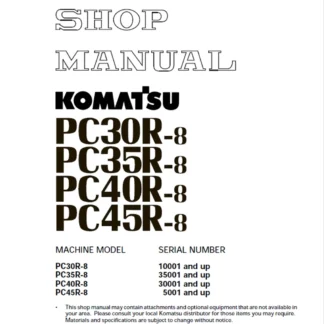
When it comes to heavy machinery, Komatsu engines are recognized for their durability and reliability. However, like all mechanical systems, they require regular maintenance and occasional overhauls to continue performing at their best. Repairing and overhauling Komatsu engines is a complex process that demands precise adherence to manufacturer guidelines. This article delves into the importance of following these guidelines, the key steps in overhauling Komatsu engines, the recommended tools and equipment, and common challenges encountered during engine overhauls, along with their solutions.
Importance of Manufacturer Guidance for Engine Repairs
Adhering to manufacturer guidance when repairing Komatsu engines is crucial for several reasons. First and foremost, the manufacturer has the most comprehensive understanding of their engines’ design and operational parameters. This knowledge is encapsulated in their manuals, which provide detailed instructions on disassembly, inspection, repair, and reassembly. Ignoring these guidelines can lead to improper repairs and potentially catastrophic engine failures.
Moreover, following the manufacturer’s guidance ensures that all repairs meet the original equipment manufacturer’s (OEM) standards. This is vital for maintaining the engine’s performance, efficiency, and longevity. Deviating from these standards can result in suboptimal engine performance and increased wear and tear on components, leading to more frequent breakdowns and higher maintenance costs.
Another critical aspect is safety. Komatsu’s repair manuals include specific safety procedures that must be followed to prevent accidents and injuries. Heavy machinery engines are complex and powerful, and improper handling can lead to severe consequences. The manufacturer’s guidelines provide step-by-step instructions to safely manage the repair process.
In addition, using the manufacturer’s guidance helps in warranty compliance. Many Komatsu engines come with warranties that could be voided if repairs are not conducted according to the specified procedures. To protect these warranties and ensure any claims are honored, it’s essential to stick to the instructions provided by Komatsu.
The manufacturer’s guidance also includes updates and technical bulletins that address known issues and improvements. These updates are crucial for ensuring that repairs incorporate the latest enhancements and fixes, thereby optimizing engine performance and reliability.
Finally, Komatsu’s repair manuals offer troubleshooting advice that can help identify the root cause of engine problems more efficiently. This can save valuable time and resources by avoiding unnecessary repairs and parts replacements, ensuring that the engine is restored to optimal condition as quickly as possible.
Key Steps in Overhauling Komatsu Engines
Overhauling a Komatsu engine is a detailed process that involves several critical steps to ensure the engine is restored to its optimal condition. The first step is thorough diagnostic testing to identify any issues or worn components. This involves using specialized diagnostic tools to assess the engine’s performance and pinpoint any areas that require attention.
Once the diagnostic phase is complete, the next step is disassembly. This involves carefully removing the engine from the machinery and disassembling it into its individual components. Each part must be meticulously labeled and stored to ensure it can be reassembled correctly. This step requires a clean and organized workspace to prevent any contamination of engine parts.
The third step is the inspection of all engine components. This involves checking each part for wear and damage, using precision measurement tools to assess their condition. Components that are worn beyond acceptable limits must be replaced, while others may be reconditioned for further use. This step is crucial for ensuring that the overhauled engine will perform reliably.
Following the inspection, the next step is cleaning. All engine components must be thoroughly cleaned to remove any dirt, oil, or debris. This is typically done using specialized cleaning equipment and solvents. Clean components are essential for ensuring that the reassembled engine operates smoothly and efficiently.
Reassembly is the next critical step in the overhaul process. This involves carefully putting the engine back together, following the manufacturer’s guidelines to ensure each component is correctly installed and torqued to the specified settings. Attention to detail is crucial during this step to prevent any assembly errors that could affect engine performance.
Finally, the overhauled engine undergoes rigorous testing to ensure it meets the required performance standards. This involves running the engine under various conditions to simulate its operational environment and verify that all systems are functioning correctly. Any issues identified during testing must be addressed before the engine is returned to service.
Tools and Equipment Recommended by Komatsu
Komatsu provides a comprehensive list of tools and equipment required for repairing and overhauling their engines. These tools are specifically designed to work with Komatsu engines, ensuring precision and reliability during the repair process. One of the most critical tools is the diagnostic scanner, which is used to read fault codes and monitor engine performance. This tool is essential for accurately diagnosing engine issues.
Another essential tool is the torque wrench, which is used to apply the precise amount of torque to bolts and fasteners during reassembly. Using the correct torque settings is crucial for ensuring that all components are securely fastened and that the engine operates safely and efficiently. Komatsu provides specific torque values for each component in their repair manuals.
Specialized engine stands and lifting equipment are also recommended by Komatsu. These tools are necessary for safely removing and handling the engine during the disassembly and reassembly process. Engine stands provide a stable platform for working on the engine, while lifting equipment ensures that the engine can be safely moved without causing damage or injury.
Precision measurement tools, such as micrometers and calipers, are essential for inspecting engine components. These tools allow technicians to measure the dimensions of engine parts accurately and determine whether they are within the acceptable limits specified by Komatsu. Accurate measurements are crucial for identifying worn or damaged components that need to be replaced.
Cleaning equipment, such as ultrasonic cleaners and parts washers, is also recommended by Komatsu. These tools are used to thoroughly clean engine components, removing any dirt, oil, or debris that could affect engine performance. Clean components are essential for ensuring that the reassembled engine operates smoothly and efficiently.
Finally, Komatsu recommends using genuine OEM parts and fluids during the repair and overhaul process. These parts are specifically designed to work with Komatsu engines and meet the manufacturer’s quality standards. Using genuine OEM parts ensures that the overhauled engine will perform reliably and meet the required performance standards.
Common Challenges and Solutions in Engine Overhaul
Overhauling Komatsu engines can present several challenges, but understanding these challenges and their solutions can help ensure a successful repair. One common challenge is diagnosing the root cause of engine issues. This requires specialized diagnostic tools and a thorough understanding of the engine’s systems. Using Komatsu’s diagnostic tools and following their troubleshooting guidelines can help accurately identify the problem.
Another challenge is dealing with worn or damaged components. Identifying these components requires precision measurement tools and a keen eye for detail. Once identified, these components must be either reconditioned or replaced. Using genuine OEM parts and following Komatsu’s guidelines for component inspection and replacement can help ensure that all parts meet the required standards.
Contamination of engine components during the overhaul process is another common challenge. Contaminants such as dirt, oil, and debris can affect the performance and longevity of the engine. To prevent contamination, it’s essential to work in a clean and organized environment and use specialized cleaning equipment to thoroughly clean all engine components.
Reassembly errors can also pose a significant challenge. Incorrectly assembled engines can suffer from performance issues and may even fail prematurely. Following Komatsu’s detailed reassembly instructions and using the recommended tools and torque settings can help ensure that the engine is correctly assembled and operates reliably.
Testing the overhauled engine to ensure it meets the required performance standards is another critical challenge. This involves running the engine under various conditions to simulate its operational environment. Any issues identified during testing must be addressed before the engine is returned to service. Following Komatsu’s testing procedures and guidelines can help ensure that the overhauled engine meets the required performance standards.
Finally, ensuring that all repairs comply with warranty requirements can be a challenge. Many Komatsu engines come with warranties that could be voided if repairs are not conducted according to the specified procedures. To protect these warranties and ensure any claims are honored, it’s essential to follow the instructions provided by Komatsu and use genuine OEM parts and fluids.
Repairing and overhauling Komatsu engines is a complex and demanding process that requires strict adherence to manufacturer guidelines. From the importance of following these guidelines to the key steps in the overhaul process, the recommended tools and equipment, and common challenges and their solutions, understanding and following Komatsu’s instructions is crucial for ensuring successful repairs. By doing so, technicians can ensure that Komatsu engines continue to perform reliably and efficiently, maximizing their lifespan and minimizing downtime. For more detailed instructions and guidelines, visit the Komatsu Manual website.






